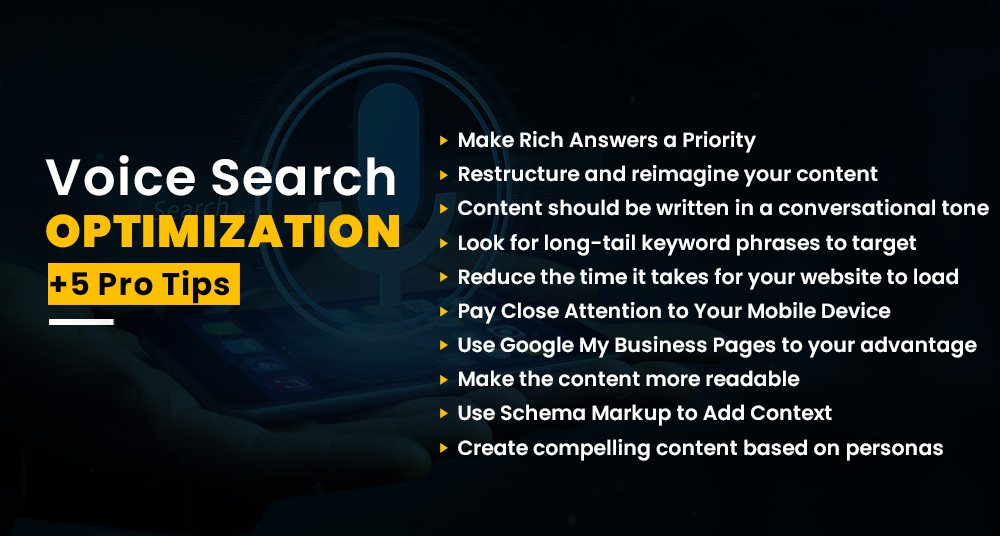Although voice search began as a tiny notion, it has grown to become one of the top essential themes in the search market. Individuals are enamored with the ease with which they can search using speech, and many can’t do much else.
Voice search began with smartphones and soon spread to voice assistants and smart speakers worldwide. Today, we witness a voice search revolution, with practically every generation enthusiastically embracing technology. As technology advances, voice chatting is also getting more reliable. The voice assistant is no longer a passing trend.
A Dialogue System for Voice Search
For those who are still unsure, voice search is a dialogue mechanism. One that is considerably better and more advanced.
What is the definition of a dialogue system?
- As the name implies, a conversation system is a computer configuration designed to converse with a human being. It uses several kinds of communication as input and output signals, such as text, speech, gestures, etc.
- Even though each dialogue system has its number of components, a dialogue administrator is present in all of them. It manages the dialogue approach and analyses the semantics.
- The first talking dialogue system was used in 1977, and there has been continuous study and improvement since then. We’ve come a long way with technology breakthroughs to produce among the most effective dialogue systems.
- Automatic speech recognition (ASR) can supply voice search devices with input signals. Text-to-speech (TTS) is also included in some of them for sharing findings.
- You don’t have to enable the virtual assistant instead of using a voice search gadget. The device will identify the languages in which the inquiry was asked as soon as it receives input. The question’s keywords will be collected and will reply to the query as well.
- The results may be displayed on some devices with screens, but all other devices will respond to the searcher. The conversational tone of voice search devices is one of the key reasons for their popularity and demand.
Content Marketing Strategies for Google Voice Search Optimization

Marketers and SEOs should make it a habit to optimize their content for voice search in the era of voice search, wherein competition will only get stronger in the coming days. This recommended practice will help you improve your voice search ranks and expand your organic reach.
Try these attempted voice search optimization techniques:
Make Rich Answers a Priority
“70 percent of all responses provided from voice searches filled a SERP feature (with 60 percent of them delivering a Featured Snippet result),” according to SEMrush voice search research. Most intelligent gadgets with voice search capabilities are likely to respond to specific inquiries with a similar response, primarily a rich answer to the question.
To better comprehend this, we’ll need to familiarise acquainted with some SEO terms:
- Google’s knowledge base, which collects and absorbs all the varied data about people, places, and things, is known as the Knowledge Graph.
- Knowledge Panel – When we seek a business on Google, we see information (in a bit of a box) to the right of the search engine results. The Knowledge Graph provides all of this information.
- Knowledge Box – Like the Knowledge Panel, this is accurate information from the Knowledge Graph that appears alongside other search results.
- Featured Snippet – Google displays this information from third-party sources, above organic results, and above advertising, with credit to the actual source; this is done to offer consumers quick and concise answers.
- Rich Response – A rich answer is a search result including any elements mentioned above.
Google mainly provides rich answers to questions to provide the most incredible user experience, and there has been a significant increase in these over the years.
Restructure and reimagine your content
Because voice search is much more conversational than standard searches, we must rethink our content and organization. To improve the material design and make it more voice search-friendly, the goal should incorporate brief queries and answers.
According to Backlinko’s research, Google likes short, brief responses to voice search requests, with the average voice search result being only 29 words long. “Text size of the answers given was virtually the same for every device (approximately 41 words on average),” according to an SEMrush voice activation study for Google Assistant.
These are helpful suggestions for structuring our material to rank higher in voice search results.
Use Frequently Asked Questions (FAQs) on your shopping sites and blogs because they contain inquiry keywords and are relatively brief. Both of these elements are necessary for voice search engine rankings. Google can quickly grab content from your site and present it as a rich sample, thanks to the FAQ-style format.
A voice search best practice that aids in higher ranking is using pointers to separate your material into small parts.
Content should be written in a conversational tone.
A significant property of a voice search engine is that it is conversational, and we must take advantage of this. The more robotic language we use in our material, the less likely we will show up in voice search engine results.
Utilizing natural language in everything we write and share on the web can be beneficial. When natural language is used, there is a lot of room for matching due to spoken inquiry.
If you want to understand how individuals ask spoken queries, you must first understand the searcher’s intent. You should research and anticipate the queries individuals perform when utilizing voice search.
- What keywords do people use when they ask questions?
- What kind of conversational style do they have?
- What are the most frequently asked questions?
- What kinds of responses are most appropriate for these questions?
- What are the best-performing answers that show up in voice search results?
Data-driven insights depending on the responses to the above queries will give you a sense of what individuals search for when they search audibly.
Look for long-tail keyword phrases to target.
Yes, due to their everyday character, voice searches take longer than searches done on a keyboard. Furthermore, we all believe Google favors long-form, comprehensive material. We won’t be able to create material for every voice search word independently, but we will be able to include those terms in a single post.
Material developers can take advantage of this by creating long-form content that includes all long-tail keywords found in spoken queries.
Long-tail keywords, as well as filler terms, should be prioritized to achieve the most outstanding results in voice search engine rankings.
Reduce the time it takes for your website to load.
Despite the fact that it is such an essential aspect in voice search, it frequently goes ignored. But that doesn’t make it any less significant.
Compared to the few who load quickly, webpages that take more time to load are rapidly abandoned. The speed with which a website loads has a direct effect on website traffic, and as a result, it should be maximized at all costs.
Google’s Speed Update, which focuses on optimizing website load speeds, has added some urgency. The restrictions are very much the same when it comes to voice searches. Voice searchers want instant responses; therefore, if your website is slow and takes an age to load, your material will not be used to respond to voice requests.
Overall, slow page loading times might impact the bounce rate and growth rate of your website.
Pay Close Attention to Your Mobile Device
At Google I/O 2019, all significant announcements were either directly linked to mobile or tools tied to mobile. Google prioritizes the digital app and pledges to improve it on a daily basis.
Because most vocal questions are asked on mobile, it easily outperforms other platforms when it refers to voice search queries. It would help if you were fully prepared to provide an exceptional mobile user experience.
It’s critical to create mobile-friendly information with a mobile-first strategy, and there are a few ways to do so:
1. Create a mobile-friendly website.
2. Perform a mobile-friendly test on your website and make necessary adjustments.
3. The site should be searchable to ensure that your information gets seen and heard.
Mobile is the way of the future for research, including voice searches. Having a mobile-friendly webpage is an SEO best practice that should not be overlooked.
Use Google My Business Pages to your advantage.
We already know that individuals use their voices to search for things “near me.” The Google My Business page is the criteria that decide whether we score for specific queries.
A Google My Business page informs Google that your company is located in a specific location. Your company could appear for that query if someone asks Google to show them similar businesses in the region.
Your identity, location, and phone number must all be included in your listing (NAP). Additionally, picking the right business categories and providing area codes are crucial. To make your product stand out, you may also contribute posts with special promotions, news, or updates.
So, if you still don’t have a Google Business page, now is the time to get one. Optimize your local SEO, and you’ll see results almost immediately.
Targeting local keywords and gaining higher search rankings is another strategy to rank for “near me” queries. It is highly suggested that structured data be embedded using Schema.org for optimal search engine performance.
Make the content more readable
Writing good, digestible material is very much a given, but we still manage to ignore it. Our content is better ranked when written precisely and at an average reading level.
The best practice is to avoid technical jargon and speak in plain English.
Use Schema Markup to Add Context
Familiarize yourselves with schema markup if you haven’t before.
To notify search results what your site is about, use schema to label your content.
This HTML add-on aids search engines in comprehending the environment of your material, allowing you to rank higher in general searches and be more relevant in voice search inquiries.
By adopting schemas, Google can interpret language, and they can be an excellent method to add extra info to your website, so you’re prepared to answer inquiries. So, according to the Milestone Marketing strategy, significant increases of +20-30% were identified based on 9,400 schema installations — with an average of 40 schema types. There are 130 traits and properties in total. This is the type of data that mobile phone users and voice searchers will be looking for the most.
Create compelling content based on personas.
Simplicity, clarity, and relevancy are all important factors to consider when optimizing for voice search. What distinguishes this SEO strategy from others is the fact that you must now pay special attention to:
– Developing detailed responses to frequently asked questions.
– Clearly and concisely answering simple questions.
Create substantial, compelling content that targets and solves your customers’ most pressing problems.
– Develop content or a website with a title that asks a frequent question.
– Provide one precise answer or explanation to the question immediately below the headline.
– Use the remains of the webpage to provide more information about the subject.
The critical aspect of this method is that the rich, strong webpage appeals to Google’s ranking algorithm in the end.
At the very same time, the top of the page’s short-and-sweet material is optimized for voice recognition and may potentially become a highlighted snippet.
Conclusion
With each passing year, voice search grows in popularity, and it will soon be universal, with everybody talking about it. Consumer behavior is ever-changing, and advertisers must be ready to respond to any marketing trend to satisfy customer expectations.
Many tech behemoths have already adapted and optimized for voice search in order to get an advantage over their competitors. You must specialize in voice search SEO and marketing in order to compete.
The strategies listed above will help you improve your voice search engine rankings and create a sound voice search optimization strategy. Because voice is a winner-take-all search result, it’s necessary to end up thinking about it and start optimizing for it.






What do you think?
It is nice to know your opinion. Leave a comment.